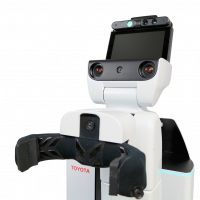Coming Soon: Personal In-Home Robots

The age of robot butlers is almost upon us.
Toyota has been working on developing personal helper robots for the past couple of years. It recently got one step closer to making them commercially available by conducting the first in-home trial in North America.
The Human Support Robot (HSR) is a mobility assistance robot the automaker designed to help the elderly and disabled in their homes. It has a telescoping body that scoots around on a round base with wheels, much like a Roomba, and has video camera sensors to help it navigate.
But the most useful feature of the HSR is that it can fetch, carry, and pick things up off the floor. It has a mechanical arm that can grasp water bottles, pens, TV remotes, and other small objects, and a suction cup for retrieving lighter items, such as pills or papers. It can also perform tasks such as opening doors and closing curtains.
The robot is controlled using a tablet or smartphone, with users accessing the video feed from the robot's cameras and then simply tapping on whatever they want it to retrieve. A screen on top of the head also allows video calls, meaning family members or nurses in a remote location can check in. They can even control the robot to dispense medication.
The HSR trial that was just completed in North America was conducted with US Army Rangers veteran Romy Camargo, who suffered injuries in combat in Afghanistan that left him paralyzed below the neck. It’s the first time the robot was tested outside a lab environment with a real person who would be an intended user.
“When they opened the box and I saw the robot, I figured we would unfold the next chapter in human support robots helping people with disabilities,” Camargo said. “Like, we’re going to change the world.”
Toyota is also involved in developing other technologies to help people with limited mobility, including a wearable robotic leg brace designed to help partially paralyzed people walk, a robot that can lift people out of beds or chairs, and a special seat to assist people who have difficulty getting in and out of their vehicles.
The HSR is no Rosie from The Jetsons, but its capabilities can definitely help people with limited mobility be more independent. And with further tests and interest, it’s likely that one day these robots will be available in any home to improve everyone’s quality of life.

